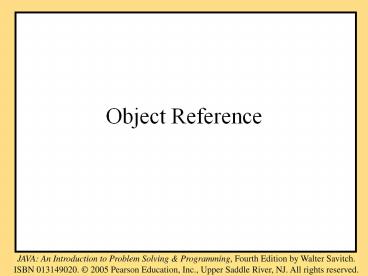Object Reference - PowerPoint PPT Presentation
Title:
Object Reference
Description:
Title: Chapter 4 Defining Classes and Methods Author: Robert P. Burton Last modified by: Philip Chan Created Date: 9/6/2004 10:40:40 PM Document presentation format – PowerPoint PPT presentation
Number of Views:17
Avg rating:3.0/5.0
Title: Object Reference
1
Object Reference
2
Variables Class Type vs. Primitive Type
- What does a variable hold?
- primitive type
- value of the variable
- class type
- memory address (reference) of the object
- not the value(s) of the object
- objects generally do not have a single value and
they also have methods, so whats its "value?
3
Post Office Analogy
4
Whats the pink card for and why?
5
Mailboxes and Java
- Letters smaller, standard sizes (primitive type
objects) - Packages larger, no standard sizes (class type
objects) - Mailbox (variable)
- Primitive type Letter itself (value/content of a
primitive type object) - Class type Pink card to get the package
(reference/pointer/address of a class type
object)
6
Advantages of separate treatment
- Mailboxes are tightly packed and well organized
(primitive types) - Efficient access and storage
- Packages are not as well organized (classes
types) - Less efficient access and storage
- Different memory segments for primitive type
objects (mailboxes) and class types objects (back
of the mailroom) - Easier to move a package or a pink card around?
- Parameter passingfaster to pass an address than
a class type object - Returning from methods
7
Allocating Memory for a Reference and an Object
- A declaration such as
- SpeciesFourthTry s
- creates a variable s that can hold a memory
address (reference). - A statement such as
- s new SpeciesFourthTry()
- allocates memory for an object of type
SpeciesFourthTry and assign its memory address
to variable s.
8
Issues with Class Type Variables
- Assignment ()
- Equality ()
- Parameter passing
9
Assignment withVariables of a Class Type
klingon.set(Klingon ox, 10, 15) earth.set(Blac
k rhino, 11, 2) earth klingon earth.set(Elep
hant, 100, 12) System.out.println(earth) ear
th.writeOutput() System.out.println(klingon)
klingon.writeOutput()
What will the output be? (see the next slide)
10
Assignment withVariables of a Class Type
klingon.set(Klingon ox, 10, 15) earth.set(Blac
k rhino, 11, 2) earth klingon earth.set(Elep
hant, 100, 12) System.out.println(earth) ear
th.writeOutput() System.out.println(klingon)
klingon.writeOutput()
Output
earth Name Elephant Population 100 Growth
Rate 12 klingon Name Elephant Population
100 Growth Rate 12
What will the output be? klingon and earth both
print Elephant. Why do they print the same
thing? (see the next slide)
11
Assignment withVariables of a Class Type
klingon.set(Klingon ox, 10, 15) earth.set(Blac
k rhino, 11, 2) earth klingon earth.set(Elep
hant, 100, 12) System.out.println(earth) ear
th.writeOutput() System.out.println(klingon)
klingon.writeOutput()
Why do they print the same thing? The assignment
statement makes earth and klingon refer to the
same object. When earth is changed to Elephant,
klingon is changed also.
12
Variables of a Class Type
13
Assignment with Variables of a Class Type
- Aliases
- Multiple class variables that have the same
memory address - They point to the same object
Species mouse new Species(Mouse, 10,
5) Species cat mouse Species lion cat //
lion and cat are aliases of mouse
14
Comparing Class Variables
- A class type variable
- memory address of the object
- Equality operator with two class variables
- the addresses of the objects are compared!
- not the content of the objects
- rarely what you want to do!
- Use the classs equals() method to compare the
content of objects referenced by class variables
15
Example Comparing Class Variables
//User enters first string String firstLine
keyboard.nextLine() //User enters second
string String secondLine keyboard.nextLine() i
f(firstLine secondLine) //this compares their
addresses ltbody of if statementgt if(firstL
ine.equals(secondLine)) //this compares their
values ltbody of if statementgt
- Use equals() method (not the double-equals sign)
to compare class variables
16
with Class Type Variables
17
with Class Type Variables
18
with Class Type Variables
19
Programming Example
20
Programming Example, contd.
21
Class Types as Method Parameters
- class variable names used as parameters in a
method call - copy the address in the argument to the formal
parameter - formal parameter name contains the address of the
argument - the formal parameter name is an alias for the
argument name - Any action taken on the formal parameter
- is actually taken on the original argument!
- Different for parameters of primitive types
- the original argument is not protected for class
types!
22
Class Parameters, cont.
- Example
- if (s1.equals(s2))
- public boolean equals(Species otherObject)
- causes otherObject to become an alias of s2,
referring to the same memory location, which is
equivalent to - otherObject s2
23
Example Class Type as a Method Parameter
//Method definition with a DemoSpecies class
parameter public void makeEqual(DemoSpecies
otherObject) otherObject.name this.name
otherObject.population this.population
otherObject.growthRate this.growthRate //Met
hod invocation DemoSpecies s1 new
DemoSpecies("Crepek", 10, 20) DemoSpecies s2
new DemoSpecies() s1.makeEqual(s2) // s2 is
changed!
- The method call makes otherObject an alias for
s2, therefore the method acts on s2, the
DemoSpecies object passed to the method! - This is unlike primitive types, where the passed
variable cannot be changed.
24
Comparing Class Parameters and Primitive-Type
Parameters, cont.
25
Comparing Class Parameters and Primitive-Type
Parameters, cont.































